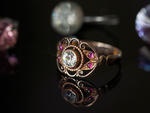Jewelry made from synthetic diamond
Direktzugriff
Artikelaktionen
The global demand for diamond is rising. An alternative to the popular raw material is synthetically produced diamond.
»Diamonds are a girl’s best friend« – ever since Carol Channing sang these lines in 1949, nothing has changed. Diamond as a gemstone in jewelry is highly popular – especially in the USA, China and Europe. In five years, the demand for raw diamond is even expected to exceed the offer, says a study of Bain & Company and the Antwerp World Diamond Centre, which was published in March 2015. Synthetic diamond could enrich the market in future and form an alternative to the natural resource. While the complexity of the production process for the so-called man-made diamonds has previously been criticized, researchers from Fraunhofer IAF now present a novel method facilitating the serial production of single crystalline diamond.
»We can grow 600 diamonds at a time. That’s unique all over the world«, explains Dr. Christoph Nebel, Head of Department at Fraunhofer IAF. »The special reactor design allows to create a large-volume plasma and thus to deposit diamond on a large surface«. Within ten days, single crystalline diamonds can be grown in the reactor on up to 600 substrates, each sized 3 x 3 x 0.3 mm³. This equates to 190 carat of diamond. And the results are impressive: with a concentration of impurity atoms of less than 1016 cm-3, the synthetic diamond features a higher purity level than its natural equivalent. »The difference between natural and man-made diamond cannot be seen with the naked eye«, enhances Nebel. Only 15 percent of the mined raw diamonds are turned into gemstones in necklaces or rings, as the majority of the stones are too impure or unsuitably shaped. Furthermore, the complex mining procedure of natural diamond strongly affects both humans and the environment. Thanks to the synthetically manufactured stones, it could, however, be possible to produce »sustainable« jewelry in future.
For more than 15 years, the scientists at Fraunhofer IAF have perfected the process of depositing polycrystalline diamond layers through microwave-based plasma chemical vapor deposition (MWPCVD). The extraordinary design of the reactor results from the ellipsoid reflector. Through multi antenna geometry, the microwave is being coupled into the reactor chamber. Meanwhile, this procedure is mature enough to allow the parallel deposition of multiple single crystalline diamond layers in a relatively short period. Competing methods, such as the high-pressure high-temperature technique (HPHT), have so far not succeeded to process large numbers of high-purity diamonds. The required high pressure and a temperature above 1500 °C only allow the growth of individual crystals. This is different in the chemical vapor deposition conducted at Fraunhofer IAF: in a low-pressure procedure at a temperature of 800 °C, the diamond crystals are being grown with a high growth rate.
But diamond is not only nice to look at – in combination with boron or phosphorus, it can also serve as a promising semiconductor material. Due to its extraordinary heat conductivity, diamond used as a base material for power electronic components, facilitates high performances without any external cooling efforts. In future, diamond can thus not only be applied in jewelry, but also in power components for satellite communication, in lenses for high energy lasers or in single photon emitters.
Fußzeile
Benutzerspezifische Werkzeuge

